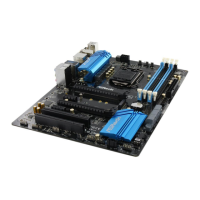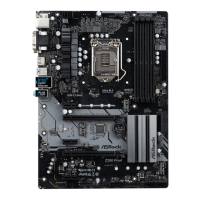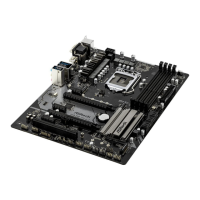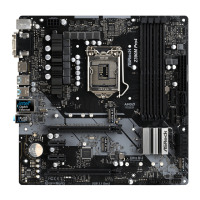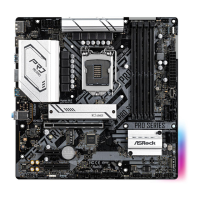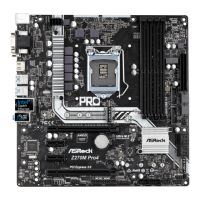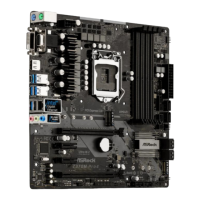Do you have a question about the ASROCK Z490M PRO4 and is the answer not in the manual?
Lists all items included in the motherboard package for the user.
Details the technical specifications of the motherboard, including platform, CPU, chipset, memory, and expansion slots.
Illustrates the physical layout of motherboard components and connectors with numbered labels for identification.
Describes the rear panel input/output ports, their functions, and includes diagrams.
Step-by-step guide on safely installing the CPU into the motherboard socket, including precautions.
Instructions for mounting the CPU cooler and fan onto the motherboard, ensuring proper thermal contact.
Guide on correctly installing DDR4 DIMM modules for optimal performance and dual-channel configuration.
Explains the different PCI Express slots and their configurations for adding expansion cards.
Details the function and setup of jumpers, particularly the Clear CMOS jumper for system resets.
Describes various onboard headers for front panel connections, fans, LEDs, and peripherals.
Explains the function of the Post Status Checker (PSC) for diagnosing system boot issues via LED indicators.
Guide on setting up AMD CrossFireX™ technology for multi-GPU configurations, including installation steps.
Instructions for installing M.2 WiFi/BT modules and Intel® CNVi components into the motherboard.
Step-by-step guide for installing M.2 SSD modules into the specified M.2 slots on the motherboard.
Instructions on installing system drivers and utilities from the provided support CD for optimal functionality.
Details installing and using ASRock A-Tuning for system monitoring, control, Operation Mode, OC Tweaker, System Info, FAN-Tastic Tuning, and Settings.
Guide to ASRock Live Update & APP Shop for software, drivers, and BIOS updates, covering UI, Apps, BIOS/Drivers, and Settings.
Explains the Nahimic Audio software interface for enhancing system sound and voice performance through various tabs and features.
Instructions for connecting RGB LED strips and customizing lighting effects using the ASRock Polychrome SYNC utility.
Explains how to access and navigate the UEFI SETUP UTILITY for comprehensive system configuration.
Describes the EZ Mode interface, offering a system status dashboard and basic BIOS controls.
Introduces Advanced Mode for detailed BIOS configuration, covering the menu bar and navigation keys for extensive system settings.
Overview of the UEFI Main screen, displaying system information and allowing users to manage favorite BIOS settings.
Details on configuring overclocking features, CPU/GPU settings, voltage adjustments, and saving/loading profiles.
Covers advanced system configurations including CPU, Chipset, Storage, Thunderbolt, IO, ACPI, USB, and Trusted Computing settings.
Explains various UEFI utility tools like ASRock Polychrome RGB, RAID installer, Secure Erase, and Instant Flash for system management.
Describes how to monitor system hardware status, including CPU/motherboard temperatures, fan speeds, and voltages.
Details options for setting supervisor/user passwords, configuring secure boot, and managing platform trust technology.
Guides users on configuring boot settings, priorities, and compatibility support module (CSM) options.
Explains how to save changes, discard them, or load default settings before exiting the UEFI utility.
Lists all items included in the motherboard package for the user.
Details the technical specifications of the motherboard, including platform, CPU, chipset, memory, and expansion slots.
Illustrates the physical layout of motherboard components and connectors with numbered labels for identification.
Describes the rear panel input/output ports, their functions, and includes diagrams.
Step-by-step guide on safely installing the CPU into the motherboard socket, including precautions.
Instructions for mounting the CPU cooler and fan onto the motherboard, ensuring proper thermal contact.
Guide on correctly installing DDR4 DIMM modules for optimal performance and dual-channel configuration.
Explains the different PCI Express slots and their configurations for adding expansion cards.
Details the function and setup of jumpers, particularly the Clear CMOS jumper for system resets.
Describes various onboard headers for front panel connections, fans, LEDs, and peripherals.
Explains the function of the Post Status Checker (PSC) for diagnosing system boot issues via LED indicators.
Guide on setting up AMD CrossFireX™ technology for multi-GPU configurations, including installation steps.
Instructions for installing M.2 WiFi/BT modules and Intel® CNVi components into the motherboard.
Step-by-step guide for installing M.2 SSD modules into the specified M.2 slots on the motherboard.
Instructions on installing system drivers and utilities from the provided support CD for optimal functionality.
Details installing and using ASRock A-Tuning for system monitoring, control, Operation Mode, OC Tweaker, System Info, FAN-Tastic Tuning, and Settings.
Guide to ASRock Live Update & APP Shop for software, drivers, and BIOS updates, covering UI, Apps, BIOS/Drivers, and Settings.
Explains the Nahimic Audio software interface for enhancing system sound and voice performance through various tabs and features.
Instructions for connecting RGB LED strips and customizing lighting effects using the ASRock Polychrome SYNC utility.
Explains how to access and navigate the UEFI SETUP UTILITY for comprehensive system configuration.
Describes the EZ Mode interface, offering a system status dashboard and basic BIOS controls.
Introduces Advanced Mode for detailed BIOS configuration, covering the menu bar and navigation keys for extensive system settings.
Overview of the UEFI Main screen, displaying system information and allowing users to manage favorite BIOS settings.
Details on configuring overclocking features, CPU/GPU settings, voltage adjustments, and saving/loading profiles.
Covers advanced system configurations including CPU, Chipset, Storage, Thunderbolt, IO, ACPI, USB, and Trusted Computing settings.
Explains various UEFI utility tools like ASRock Polychrome RGB, RAID installer, Secure Erase, and Instant Flash for system management.
Describes how to monitor system hardware status, including CPU/motherboard temperatures, fan speeds, and voltages.
Details options for setting supervisor/user passwords, configuring secure boot, and managing platform trust technology.
Guides users on configuring boot settings, priorities, and compatibility support module (CSM) options.
Explains how to save changes, discard them, or load default settings before exiting the UEFI utility.
| DisplayPort version | 1.4 |
|---|---|
| USB 2.0 ports quantity | USB 2.0 ports have a data transmission speed of 480 Mbps, and are backwards compatible with USB 1.1 ports. You can connect all kinds of peripheral devices to them. |
| USB 3.2 Gen 1 (3.1 Gen 1) Type-A ports quantity | 4 |
| USB 3.2 Gen 1 (3.1 Gen 1) Type-C ports quantity | 0 |
| USB 3.2 Gen 2 (3.1 Gen 2) Type-A ports quantity | 1 |
| TPM connector | Yes |
| USB 2.0 connectors | 2 |
| Audio chip | Realtek ALC1200 |
| Certification | FCC, CE, ErP/EuP |
| Component for | PC |
| Motherboard chipset | Intel Z490 |
| PC health monitoring | FAN, Temperature, Voltage |
| Audio output channels | 7.1 channels |
| Motherboard form factor | micro ATX |
| Motherboard chipset family | Intel |
| Windows operating systems supported | Windows 10 |
| OpenGL version | 4.5 |
| DirectX version | 12.0 |
| Maximum resolution | 4096 x 2304 pixels |
| Parallel processing technology support | CrossFireX, Quad-GPU CrossFireX |
| Wi-Fi | No |
| LAN controller | Intel® I219-V |
| Ethernet interface type | Gigabit Ethernet |
| Cables included | SATA |
| BIOS type | UEFI AMI |
| ACPI version | 6.0 |
| BIOS memory size | 128 Mbit |
| System Management BIOS (SMBIOS) version | 2.7 |
| RAID levels | 0, 1, 5, 10 |
| Supported storage drive types | HDD & SSD |
| Supported storage drive interfaces | SATA III |
| Memory channels | Dual-channel |
| Memory slots type | DIMM |
| Supported memory types | DDR4-SDRAM |
| Maximum internal memory | 128 GB |
| Supported memory clock speeds | 2133, 2400, 2666, 2800, 2933, 3200, 3600, 3733, 3800, 3866, 4000, 4133, 4266, 4333, 4400 MHz |
| Compatible processor series | Intel Celeron, Intel Core i3, Intel Core i5, Intel Core i7, Intel Core i9, Intel Pentium |
| Width | 244 mm |
|---|

